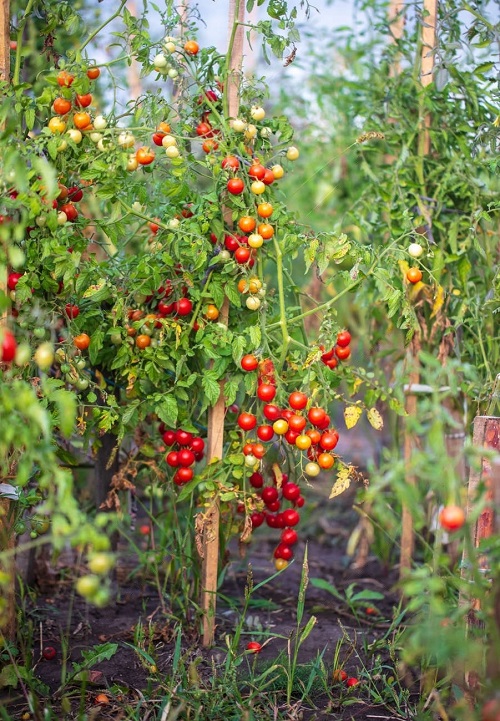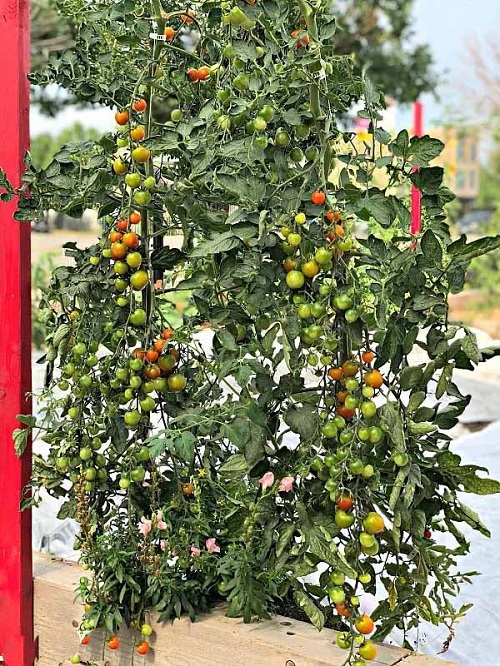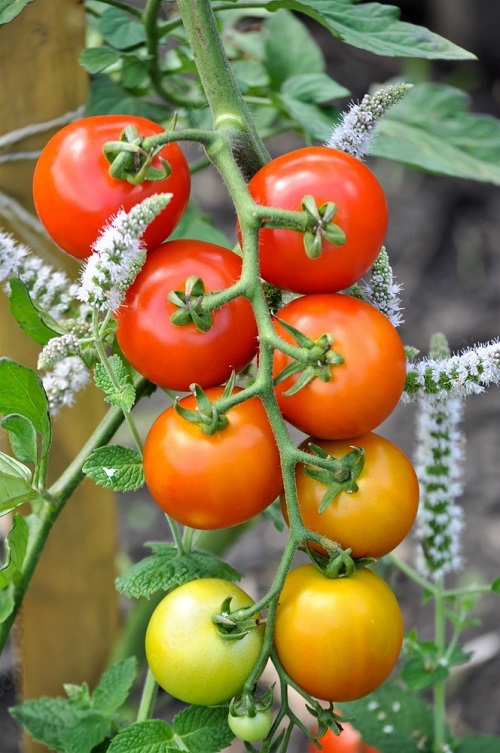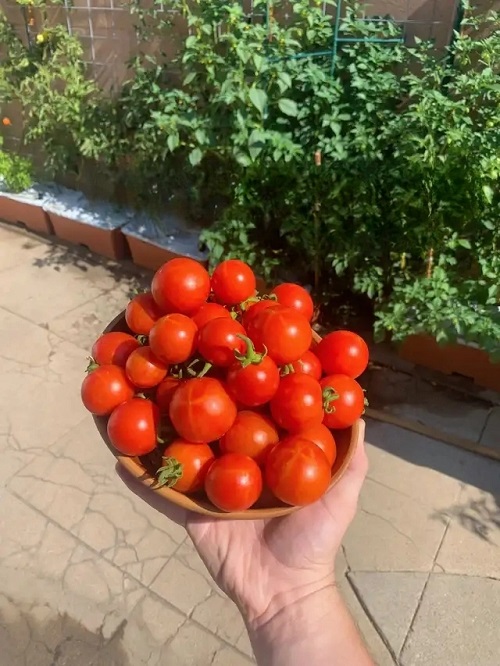Campari Tomatoes offer a delightful and juicy taste that makes them a must have for kitchens! Here are all the details on growing them!
Campari Tomatoes are the epitome of garden-fresh sweetness that have a burst of juicy flavor balanced with just the right touch of acidity. Whether you’re a tomato aficionado seeking the next best variety to grow or someone simply looking to elevate your culinary creations, Campari tomatoes offer an extraordinary experience that’s a cut above the rest!
What are Campari Tomatoes
The Campari tomato is a hybrid tomato that originated in Europe. The term “Campari” is actually a trademarked name, but it has become synonymous with a class of tomatoes that are round, small to medium in size, and exceptionally sweet. They were developed to offer consumers a tomato that provides consistent flavor year-round.
When it comes to taste, Campari tomatoes are often considered one of the sweetest and most flavorful varieties available. They possess a balanced flavor profile that combines sweetness with a slight tartness, making them ideal for a wide range of culinary applications. Their high sugar content is one of their defining characteristics.
Campari tomatoes are typically about the size of a golf ball, weighing around 2 ounces each. They have a vibrant red hue and are almost perfectly round. The skin is relatively thin but not so fragile that it splits easily, making them ideal for various cooking methods.
Find Difference Between Tomato Sauce and Tomato Paste here
Culinary Applications
- Salads: Their juicy, rich flavor makes them perfect for adding to salads.
- Roasting: Their balanced sugar-acid profile makes them excellent candidates for roasting.
- Sauces: Their natural sweetness lends depth to homemade tomato sauces.
- Snacking: They are delicious enough to eat on their own, making them a convenient and healthy snack.
- Grilling: Their firm flesh holds up well on the grill.
Propagating Campari Tomato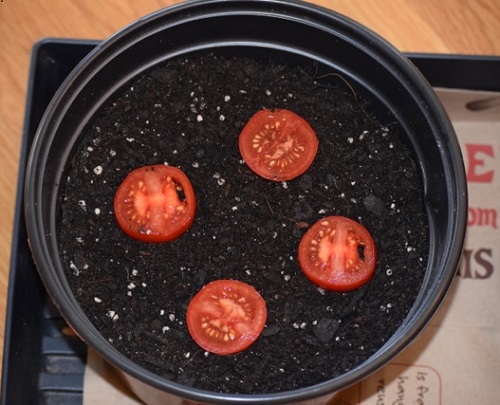
Methods to propagate Campari Tomato:
The easiest method for propagating Campari tomatoes is Seeds:
- Order Capari Tomato seeds from an online store or nursery center.
- Sow the seeds in a seed-starting tray or small pots filled with potting mix. Plant them about 1/4 inch deep.
- Water the soil lightly and cover the tray or pots with plastic wrap or a plastic dome to create a mini-greenhouse effect.
- Place the tray or pots in a warm, well-lit location, such as a sunny windowsill or under grow lights.
- Keep the soil consistently moist but not waterlogged.
- When the seedlings have grown large enough and have a few sets of true leaves (usually after 6-8 weeks), transplant them into larger pots or directly into the garden if the weather is suitable.
Growing Campari tomatoes from seeds is the most common and straightforward method for home gardeners. It allows you to select the healthiest and most vigorous plants for your garden.
Best Pot Size for Growing Campari Tomatoes
If you are looking for good growth and plentiful harvest, then choose a pot that’s at least 16-18 inches deep and wide. Depending on the growth and spread of the plant, keep on re-potting it into a one-size bigger container than the old one.
Find the Best Homemade Fertilizers for Tomatoes here
Requirements for Growing Campari Tomatoes
Light
Campari tomatoes thrive in full sun, receiving at least 6-8 hours of direct sunlight daily. This ideal light exposure promotes vigorous growth, enhances fruit production, and ensures sweet, flavorful tomatoes.
Adequate sunlight also helps prevent diseases by promoting air circulation and drying the foliage.
Soil
Campari tomatoes thrive in well-draining, loamy soil with a pH level between 6.0 and 6.8. A balanced soil mix often includes:
- 1 Part Organic Compost: Rich in nutrients and improves soil structure.
- 1 Part Peat Moss or Coco Coir: Improves water retention and provides aeration.
- 1 Part Perlite or Horticultural Sand: Ensures good drainage.
Optional Additives
- Worm Castings: Highly nutritious and helps with water retention. Add a handful per pot.
- Bone Meal: High in phosphorus, great for fruit production. Incorporate according to the package instructions.
Check Best Tomatoes for Sandwiches here
Water
For Campari tomatoes, maintain consistent soil moisture by watering deeply and evenly. Water every 2-3 days or when the top inch of soil feels dry.
Use a soaker hose or drip irrigation to deliver water at the plant’s base, avoiding wetting the foliage to prevent disease. Adjust the frequency based on weather conditions.
Best Practices
- Morning Watering: Aim to water early in the morning to reduce water loss due to evaporation and to help plants cope with heat stress throughout the day.
- Avoid Overhead Watering: Watering from above can lead to leaf diseases like blight. Always aim to water the base of the plant.
Temperature and Humidity
Campari tomatoes thrive in temperatures between 60°F to 90°F (15-32 C). They prefer moderate humidity levels around 50-70%. Protect them from frost and excessive heat.
Campari Tomatoes Care
Fertilizer
Use a balanced fertilizer, such as a 10-10-10 or 14-14-14 NPK blend. Apply the fertilizer according to the manufacturer’s instructions, usually every few weeks (Once in 6-8 weeks) during the growing season.
You can also use compost tea as a supplemental feeding method, providing a broad spectrum of nutrients.
Support
Support Campari tomatoes by using sturdy stakes or cages. As the plants grow, gently tie them to the supports to prevent sprawling and ensure proper air circulation.
This support system helps keep the fruit off the ground, reduces the risk of disease, and promotes healthier, more productive tomato plants.
Pests and Diseases
Common Pests:
Aphids: Aphids are small, soft-bodied insects that feed on the sap of tomato plants. They can cause leaves to curl and distort, leading to reduced photosynthesis and stunted growth. To control aphids, you can use insecticidal soap or neem oil and introduce beneficial insects like ladybugs.
Whiteflies: Whiteflies are tiny, white insects that feed on the underside of tomato leaves. They can transmit plant viruses and cause yellowing and wilting of leaves. Using yellow sticky traps and releasing natural predators like parasitic wasps can help manage whiteflies.
Cutworms: Cutworms are caterpillars that cut through tomato plant stems at ground level, causing the plant to wilt and die. Protective collars around young tomato plants and hand-picking cutworms can prevent damage.
Learn How to Grow Spoon Tomatoes here
Common Diseases:
Early Blight: Early blight is a fungal disease that causes dark, concentric rings on tomato leaves, leading to defoliation and reduced fruit production. To manage early blight, practice crop rotation, ensure proper spacing between plants for good airflow, and apply fungicides as needed.
Late Blight: Late blight is another fungal disease that affects tomatoes, characterized by dark, water-soaked lesions on leaves and fruit. It can spread rapidly and devastate an entire tomato crop. Remove infected plant parts promptly and apply copper-based fungicides.
Fusarium Wilt: Fusarium wilt is a soilborne disease that causes wilting, yellowing, and eventual death of tomato plants. Use disease-resistant tomato varieties and avoid planting in contaminated soil.
Blossom End Rot: Blossom end rot is a physiological disorder caused by a calcium deficiency. It results in dark, sunken spots on the bottom of tomatoes. Ensure consistent watering and proper calcium levels in the soil to prevent this issue.
Harvesting Campari Tomatoes
Signs of Ripeness
- Color: Campari tomatoes should have a vibrant red color all over.
- Texture: The skin should be smooth, and the tomato should yield slightly to gentle pressure.
- Aroma: A strong, sweet, and earthy aroma is a reliable indicator of ripeness.
Time Frame for Harvest
- Days to Maturity: Campari tomatoes generally take around 65-75 days to mature from the time of planting the seedlings.
- Weather Factors: Temperature and sunlight can influence the ripening time, so keep an eye out for visual cues.
Learn Growing Heirloom Tomatoes In Pots here
Harvesting Techniques
- Hand-Picking: Gently grasp the fruit and twist it until it snaps off the vine.
- Using Scissors or Pruners: For a cleaner cut, use garden scissors or pruners to snip the stem above the fruit.
- Handle with Care: Campari tomatoes are delicate; handle them gently to prevent bruising.
Campari Tomatoes – FAQs
1. How should I store harvested Campari tomatoes?
Store Campari tomatoes at room temperature until fully ripe, and then refrigerate to extend their shelf life. Avoid storing them in direct sunlight or near ethylene-producing fruits like apples, as this can affect their quality.
2. Can I save Campari tomato seeds for future planting?
Yes, you can save Campari tomato seeds by extracting them from ripe tomatoes, drying them, and storing them in a cool, dry place for future planting.
3. What are some popular culinary uses for Campari tomatoes?
Campari tomatoes are perfect for salads, sandwiches, and bruschettas and as a colorful garnish for various dishes. They add a burst of sweet, juicy flavor to recipes.


